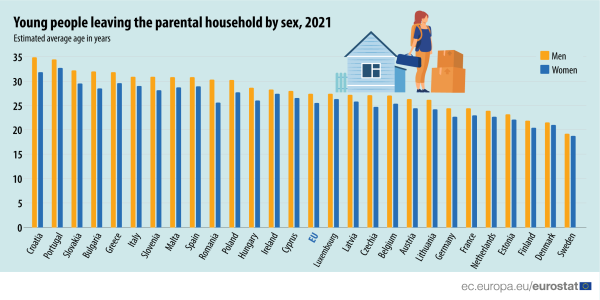Archive:Age of young people leaving their parental household
This Statistics Explained article has been archived - for recent articles on labour market see here.
Data extracted in August 2022
Planned article update: August 2023
Highlights
Leaving the parental home is considered a milestone in the transition from childhood to adulthood. The reasons behind this step may vary from being materially independent to studying, working, moving in with a partner, getting married and having children, etc. However, the path to independence may not be straightforward and may occur at different ages across EU countries, as shown in this article. This disparity may reflect the diversity of challenges that young people face across Europe, as well as cultural differences between countries.
This article presents data on the average age of leaving the parental home in the European Union (EU) as a whole, as well as in the individual EU Member States and Serbia. Special attention is given to geographical and gender differences, as well as on the developments over time.
Full article
Geographical differences
In 2021, the average age at which young people had left their parental home in the EU was 26.5 years (see Map 1).
This average varies a lot among the EU Member States. Portugal, Croatia, Slovakia, Greece and Bulgaria recorded the oldest average ages of leaving the parental home, at 30 years and over. Young people in Serbia also had left their parental household on average at an age older than 30. By contrast, Estonia, Denmark, Finland and Sweden showed the youngest average ages, 23 years or less.
The lowest average age of young people leaving their parental household was recorded in Sweden (19.0 years) while the highest was found in Portugal (33.6 years).
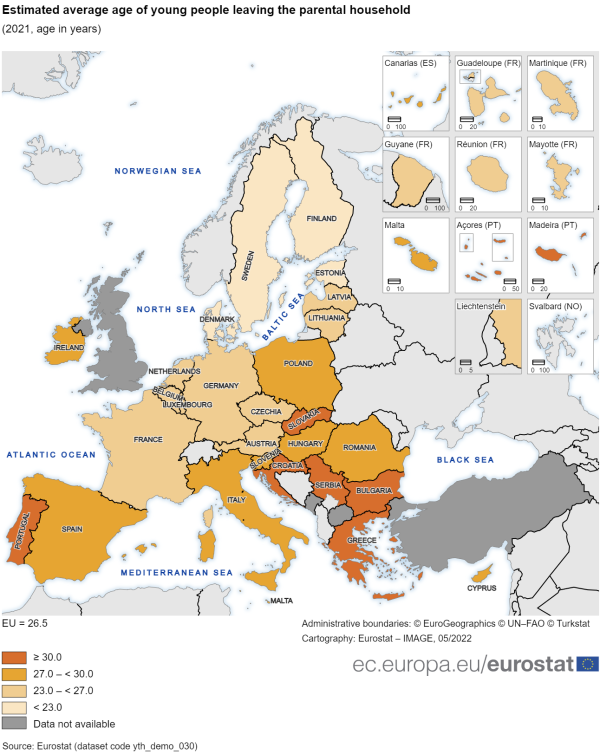
Source: Eurostat (yth_demo_030)
Gender differences
In all EU countries, young women left the parental home earlier than young men (see Figure 1). At EU level, young women left on average their parental household at the age of 25.5 years while young men did it at the age of 27.4 years.
In 11 EU countries (Croatia, Portugal, Slovakia, Bulgaria, Greece, Slovenia, Italy, Malta, Spain, Romania and Poland), men left their parental home on average after the age of 30. By contrast, women moved out of their parent's home after this age in only 2 countries (Portugal and Croatia).
In 2021, the gender gap in the average age of leaving the parental home was 1.9 years at EU level. Among EU countries, the gender gap was the largest in Romania (4.7 years), Bulgaria (3.5 years) and Croatia (3.1 years). In Serbia, the gap was even wider, with 5.0 years. By contrast, the gender gap was smaller than a year in Ireland, Denmark and Sweden.
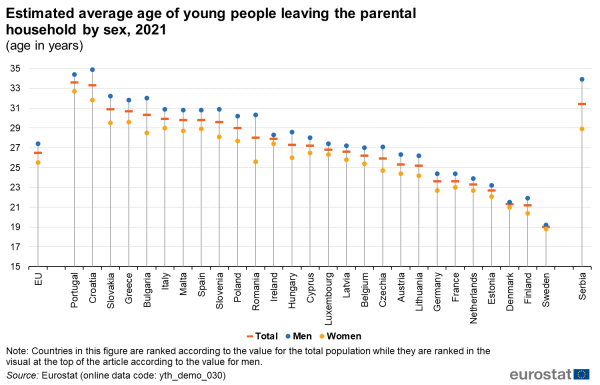
Source: Eurostat (yth_demo_030)
Furthermore, there is a strong positive correlation between the average age of young people leaving their parental household and the size of the gender gap: in the countries where the average age of young people leaving their parental household is higher, the gender gap is wider.
Development over the years
Figure 2 presents the long-term trend in the EU of the average age at which young people are moving out from the parental household.
Focusing on men, the age of moving out was 28.0 years in 2006, which was the highest point for the time series. From 2006 onwards, this age started to decline to reach its lowest point in 2019, of 27.1 years. Consequently, it dropped by almost one year between 2006 and 2019. Then, in 2020, the age of men leaving the parental home moved up by 0.3 years, the highest year-to-year increase since 2006. This important change between 2019 and 2020 was probably triggered by the COVID-19 pandemic, which might have led young people to reconsider moving out and remaining a bit longer at their parent’s home. Finally, between 2020 and 2021, the average age of young men leaving the parental household remained stable.
The long-term trend of the age at which women are leaving the parental household does not reveal as much fluctuation as for men: it only fell by 0.3 years, from 25.5 years in 2006 to 25.2 years in 2019. However, as for men, the average age of women leaving the parental household had its highest year-to-year increase from 2019 to 2020, of 0.3 years, most probably due to the COVID-19 pandemic, and then remained stable between 2020 and 2021.
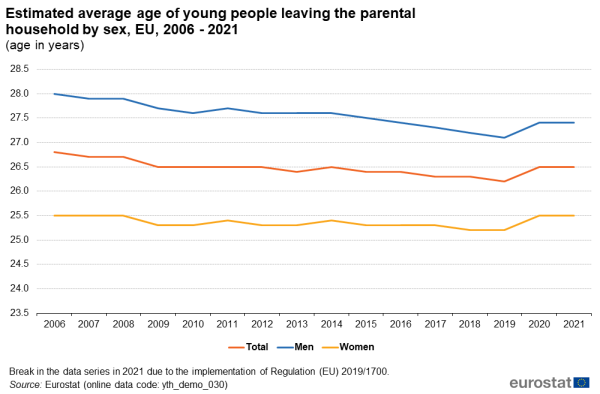
Source: Eurostat (yth_demo_030)
Correlation with the labour force participation rate
Countries, where young people leave the parental household at an older age, are more likely to have a lower labour force participation rate (also called ‘activity rate’) for young people (aged 15-29). The relation between those two indicators is shown in Figure 3. For example, most countries where young people leave their parental home at an age older than 29 years have a lower labour force participation rate for people aged 15-29, around or below 50 %.
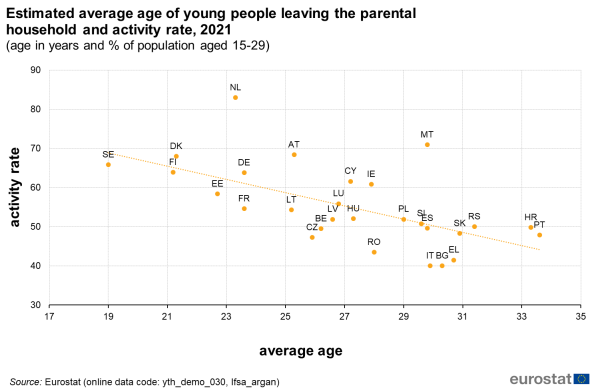
Source: Eurostat (yth_demo_030), (lfsa_argan)
Source data for graphs
Data sources
Source: Statistics presented in this article are derived from the European Union Labour Force Survey (EU-LFS). The EU-LFS is the largest European household sample survey providing quarterly and annual results on the labour participation of people aged 15 to 89. It covers residents in private households and excludes those in collective households. Conscripts in military or community service are not included in the results. The EU-LFS is based on the same target population and uses the same definitions in all countries, which means that the results are comparable between the countries.
Reference period: Yearly results are obtained as averages of the four quarters in the year.
Coverage: The results from the EU-LFS currently cover all European Union Member States, the EFTA Member States of Iceland, Norway, Switzerland, as well as the candidate countries Montenegro, North Macedonia, Serbia and Turkey. For Cyprus, the survey covers only the areas of Cyprus controlled by the Government of the Republic of Cyprus. However, EU-LFS household data are not available for Iceland, Norway, Switzerland. This is the reason why statistics are not available in this article for these three countries.
European aggregates: EU refers to the sum of the 27 EU Member States. If data are unavailable for a country, the calculation of the corresponding aggregates takes into account the data for the same country for the most recent period available. Such cases are indicated.
Country codes: Belgium (BE), Bulgaria (BG), Czechia (CZ), Denmark (DK), Germany (DE), Estonia (EE), Ireland (IE), Greece (EL), Spain (ES), France (FR), Croatia (HR), Italy (IT), Cyprus (CY), Latvia (LV), Lithuania (LT), Luxembourg (LU), Hungary (HU), Malta (MT), the Netherlands (NL), Austria (AT), Poland (PL), Portugal (PT), Romania (RO), Slovenia (SI), Slovakia (SK), Finland (FI), Sweden (SE), Montenegro (ME), North Macedonia (MK), Serbia (RS) and Turkey (TR).
Different articles on detailed technical and methodological information are available through: EU labour force survey.
Methodological note
The average age at which young people leave home is an approximate measure based on whether or not respondents and their parents live in the same household. A calculation is made for each single year of age in the range from 15 to 34. In the calculation, the share of respondents living in households without their parents among the total population (separately for males and females) is taken into consideration. A so-called ‘exit probability’ for each single year of age in the range from 15 to 34 is calculated for the total, male and female populations. The exit probability equals the above-mentioned share minus the corresponding share for the preceding age (e.g. the share for the 16 year-old people minus the share for 15 year-old people). As 15 years is the starting point, its exit probability equals the share of people aged 15 years living without their parents of the total population aged 15 years. The calculation is made successively up to the age of 34.
Context
In addition to the Labour Force Survey (LFS), the EU-Statistics on Income and Living Conditions (EU-SILC) is also a source of household statistics. The EU-SILC is a multi-purpose instrument which focuses mainly on income. However, information on housing conditions, social exclusion, labour and education is also collected.
Direct access to
- EU labour force survey — online publication
- Labour force survey in the EU, EFTA and candidate countries — Main characteristics of national surveys, 2020, 2022 edition
- Quality report of the European Union Labour Force Survey 2020, 2022 edition
- The life of women and men in Europe. A statistical portrait - 2020 edition
- Report on the impact of demographic change
- Household composition, poverty and hardship across Europe - 2013 edition
- European Union Labour force survey - selection of articles (Statistics Explained)
- Youth
- Youth population (yth_demo)
- Child and youth population on 1 January by sex and age (yth_demo_010)
- Ratio of young people in the total population on 1 January by sex and age (yth_demo_020)
- Estimated average age of young people leaving the parental household by sex (yth_demo_030)
- Share of young adults aged 18-34 living with their parents by age and sex - EU-SILC survey (ilc_lvps08)
- Youth population on 1 January by sex, age and country of birth (yth_demo_060)
- Young immigrants by sex, age and country of birth (yth_demo_070)
- Young emigrants by sex, age and country of birth (yth_demo_080)
- Youth population (yth_demo)
- Households statistics - LFS series (ESMS metadata file — lfst_hh_esms)
- Employment and unemployment (Labour Force Survey) (ESMS metadata file — employ_esms)
- Income and living conditions (ESMS metadata file — ilc_esms)
